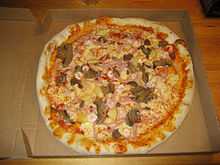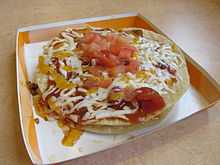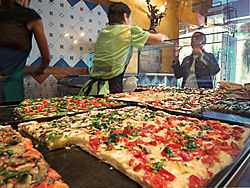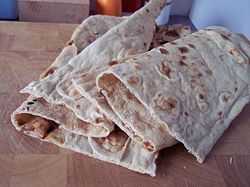List of pizza varieties by country

| Part of a series on |
| Pizza |
|---|
.jpg) |
|
Main articles |
|
Pizza varieties
|
|
Cooking variations |
|
Pizza tools
|
|
Related articles |
|
Similar dishes |
During the latter half of the 20th century, pizza became a globally accessible dish, mainly due to Italian immigrants that had brought their dishes to new people with resounding success, often in racially and culturally resistive environments.
A survey from 2004 showed that Norwegians eat the most pizza (5.4 kg/person*year), followed by Germans.[1]
Australia
Australia
The usual Italian varieties are available, though more common is the style popular in the U.S., with more and richer toppings than Italian style. A common unique type is the Aussie, Australian or Australiana which has the usual tomato sauce base and mozzarella cheese with bacon and egg (seen as quintessentially Australian breakfast fare).[2] Pizzas with seafood such as prawns are also popular. In the 1980s some Australian pizza shops and restaurants began selling "gourmet pizzas", that is, pizzas with more expensive ingredients such as salmon, dill, bocconcini, tiger prawns, or unconventional toppings such as kangaroo, emu and crocodile. "Wood-fired pizzas", that is, those cooked in a ceramic oven heated by wood fuel, are well-regarded.
Franchised chains coexists with independent pizzerias, Middle-Eastern bakeries and kebabs shops.
Asia
Bangladesh

Pizza became a popular fast food in Bangladeshi urban areas. Introduction of various branded pizza such as Domino's and Pizza Hut in early to mid-2000s, it has reached almost all classes of urban peoples.
India
Pizza is an emerging fast food in Indian urban areas. American pizza chains Domino's Pizza and Pizza Hut opened their first outlets in India in 1996.[3][4] Domestic pizza brands include U.S.Pizza, Smokin' Joes and Pizza Corner. Branded pizza is available in most cities in India.[5]
Pizzas served in India by foreign pizza brands feature greater "recipe localization" from pizza makers than many other markets such as Latin America and Europe, but similar to other Asian pizza markets. Indian pizzas are generally spicier and more veggie-oriented than those in other countries. For instance, oregano spice packs are included with a typical pizza order in India instead of Parmesan cheese.[4]
Pizza outlets serve pizzas with several Indian-style toppings like Tandoori Chicken and Paneer. Along with Indian variations, more conventional pizzas are also eaten. Pizzas available in India range from localized basic variants available in neighborhood bakeries, to gourmet pizzas with exotic and imported ingredients available at specialty restaurants.
Japan
American pizza chains entered Japan in the 1970s (e.g. Shakey's Pizza and Pizza Hut 1973, Domino's pizza in 1985). The largest Japanese pizza chain is Pizza-La. Local types of pizza are popular, with many using mayonnaise sauces, and sometimes other ingredients such as corn, potatoes, avocado, eel, or even honey or chocolate (as in dessert). "Side orders" also often include items such as french fries, fried chicken, baked pasta, as well as vegetable soups, green salads, desserts, and soda or Japanese tea.[6] There is also a strong connection to using Tabasco sauce on cooked pizzas.
Local crust variants also exist, for instance mochi pizza (crust made with Japanese mochi cakes).[7][8] Traditional pizza served in Italian-style restaurants are also popular, and the most popular pizza chain promoting Italian style artisanal pizza is Salvatore Cuomo. The Italian association Associazione Verace Pizza Napoletana also has an independent branch in Japan.
Korea
Pizza is a popular snack food in South Korea, especially among younger people. Major American brands such as Domino's, Pizza Hut, and Papa John's Pizza compete against domestic brands such as Mr. Pizza and Pizza Etang, offering traditional as well as local varieties which may include toppings such as bulgogi and dak galbi. Korean-style pizza tends to be complicated, and often has nontraditional toppings such as corn, potato wedges, sweet potato, shrimp, or crab. The super-deluxe "Grand Prix" at Mr. Pizza has Cajun shrimp, bell peppers, olives, and mushrooms on one half, and potato wedges, bacon, crushed tortilla chips, and sour cream on the other half. Its potato mousse-filled cookie dough crust is sprinkled with sunflower seeds, pumpkin seeds, and raisins, and can be dipped in a blueberry sauce that is provided.
Traditional Italian-style thin-crust pizza is served in the many Italian restaurants in Seoul and other major cities. North Korea's first pizzeria opened in its capital Pyongyang in 2009.[9]
Malaysia
Pizza restaurants in Malaysia include Domino's, Pizza Hut, Papa John's, Jom Pizza, and Sure Pizza.
Nepal
Pizza is becoming more popular as a fast food in the urban areas of Nepal, particularly in the capital city, Kathmandu. There are a number of restaurants that serve pizzas in Kathmandu. With the opening of number of international pizza restaurants, the popularity as well as consumption has markedly increased in recent times.
Pakistan
The first pizzerias opened up in Karachi and Islamabad in the late 1980s, with Pappasallis serving pizza in Islamabad since 1990. Pizza has gained a measure of popularity in the eastern regions of Pakistan—namely, the provinces of Sindh, Punjab, and Azad Kashmir, as well as the autonomous territory of Gilgit-Baltistan. Pizza has not penetrated into western Pakistan; of the remaining provinces and territories of Pakistan, only one (Khyber Pakhtunkhwa) has seen much of the dish, in the form of a single Pizza Hut in Peshawar.[10] In Pakistan Chicken Tikka and Achari Chicken Pizzas are popular.In the regions where pizza is known, spicy chicken and sausage-based pizzas are very popular, as they cater to the local palate.
Europe
Italy

Authentic Neapolitan pizzas (pizza napoletana) are typically made with tomatoes and Mozzarella cheese. They can be made with ingredients like San Marzano tomatoes, which grow on the volcanic plains to the south of Mount Vesuvius, and mozzarella di bufala Campana, made with the milk from water buffalo raised in the marshlands of Campania and Lazio in a semi-wild state (this mozzarella is protected with its own European protected designation of origin).[11]
According to the rules proposed by the Associazione Vera Pizza Napoletana,[12] the genuine Neapolitan pizza dough consists of wheat flour (type 0 or 00, or a mixture of both), natural Neapolitan yeast or brewer's yeast, salt and water. For proper results, strong flour with high protein content (as used for bread-making rather than cakes) must be used. The dough must be kneaded by hand or with a low-speed mixer. After the rising process, the dough must be formed by hand without the help of a rolling pin or other machine, and may be no more than 3 millimeters (0.12 in) thick. The pizza must be baked for 60–90 seconds in a 485 °C (905 °F) stone oven with an oak-wood fire.[13] When cooked, it should be crispy, tender and fragrant. There are three official variants: pizza marinara, which is made with tomato, garlic, oregano and extra virgin olive oil, pizza Margherita, made with tomato, sliced mozzarella, basil and extra-virgin olive oil, and pizza Margherita extra made with tomato, mozzarella from Campania in fillets, basil and extra virgin olive oil. The pizza napoletana is a Traditional Speciality Guaranteed (Specialità Tradizionale Garantita, STG) product in Europe.[14][15]
Pizza in Lazio (Rome), as well as in many other parts of Italy, is available in two different styles. Take-away shops sell pizza rustica or pizza al taglio.[16] This pizza is cooked in long, rectangular baking pans and relatively thick (1–2 cm). The pizza is often cooked in an electric oven. It is usually cut with scissors or a knife and sold by weight. In pizzerias, pizza is served in a dish in its traditional round shape. It has a thin, crisp base quite different from the thicker and softer Neapolitan style base. It is usually cooked in a wood-fired oven, giving the pizza its unique flavor and texture. In Rome, a pizza napoletana is topped with tomato, mozzarella, anchovies and oil (thus, what in Naples is called pizza romana, in Rome is called pizza napoletana). Other types of Lazio-style pizza include pizza romana (tomato, mozzarella, anchovies, oregano, oil), pizza viennese (tomato, mozzarella, German sausage, oregano, oil), pizza capricciosa (mozzarella, tomato, mushrooms, artichokes, cooked ham, olives, oil[17]), pizza quattro formaggi: ("four cheese pizza":[18] tomatoes, and the cheeses mozzarella, stracchino, fontina and gorgonzola; sometimes ricotta is swapped for one of the latter three), pizza bianca ("white pizza":[19] a type of bread topped with olive oil, salt and, occasionally herbs,[20] such as rosemary sprigs; it is also a Roman style to add figs to the pizza, the result being known as pizza e fichi[21]), and pizza alla casalinga ("Grandma pizza": a thin layer of dough which is stretched into an oiled, square "Sicilian" pan, topped sparingly with shredded mozzarella, crushed uncooked canned tomatoes, chopped garlic and olive oil, and baked until the top bubbles and the bottom is crisp[22]).
Pizza capricciosa is a style of pizza in Italian cuisine prepared with mozzarella cheese, Italian baked ham, mushroom, artichoke and tomato.[23]
Pizza pugliese is a pizza in Italian cuisine prepared with tomato, mozzarella and onion.[24]
Sicilian pizza is pizza prepared in a manner that originated in Sicily, Italy. Just in the US, the phrase Sicilian pizza is often synonymous with thick-crust or deep-dish pizza derived from the sicilian Sfincione.[25] In Sicily, there is a variety of pizza called Sfincione.[26] It is that believed Sicilian pizza, Sfincione, or focaccia with toppings, was popular on the western portion of the island as far back as the 1860s.[27]
Bill for traditional Italian pizza
There was a bill before the Italian Parliament in 2002 to safeguard the traditional Italian pizza,[28] specifying permissible ingredients and methods of processing[29] (e.g., excluding frozen pizzas). Only pizzas which followed these guidelines could be called "traditional Italian pizzas" in Italy. On 9 December 2009, the European Union, upon Italian request, granted Traditional Speciality Guaranteed (TSG) safeguard to traditional Neapolitan pizza, in particular to "Margherita" and "Marinara".[30] The European Union enacted a protected designation of origin system in the 1990s.
Malta
The Maltese enjoy eating Italian style pizza and fast-food pizzas, as well as experimenting with various toppings, including local produce. One style of fast-food pizza is the typical pizza kwadra (square pizza), which is found in Pastizzi shops (pastizzeriji), a deep-pan pizza cut into squares, generally topped with either green olives (taż-żebbuġ), hard boiled egg and cocktail sausage (bajd u zalzett), or chicken and barbecue sauce (tat-tiġieġ). A typical Pizzerija restaurant will offer a vast number of different pizza recepies, mostly based on the Italian style ones. A typical menu would include:
- Margherita: tomato sauce, mozzarella
- Funghi: tomato sauce, mozzarella, mushrooms
- Capricciosa: tomato sauce, mozzarella, mushrooms, ham, eggs, artichoke, cocktail suasages, green olives
- Quattro Stagioni: tomato sauce, mozzarella, ham, black olives, mushrooms, artichoke, peas, salami, eggs
- Vegetariana: tomato sauce, mozzarella, mushrooms, onion, (artichoke), sweet corn, green peppers,
- Quattro Formaggi: tomato sauce, and 4 assorted cheeses, generally mozzarella, parmesan cheese, blue cheese, and goat cheese, but may vary
- Marinara: tomato sauce, mozzarella, shrimps, mussels, tuna, calamari, crab meat
- Peperoni: tomato sauce, mozzarella, peperoni
- Napolitana: tomato sauce, anchovies, olives, capers
- Hawaii: tomato sauce, mozzarella, ham, pineapple
- Maltija (Maltese): tomato sauce, goat cheese, sun dried tomatoes, Maltese sausage, onion
- Calzone (folded): tomato sauce, mozzarella, mushrooms, ham, eggs,
- Rucola: tomato sauce, mozzarella di bufala, parma ham, parmesan shavings, rucola
- Bolognese: tomato sauce, mozzarella, minced meat, onion, (fresh tomato)
- Meat Feast: tomato sauce, mozzarella, minced meat, Maltese sausage, and other meat
- Kebabpizza: tomato sauce, mozzarella, döner kebab, onion, green peperoncini, (kebab sauce poured over after baking)
- Mexicana: tomato sauce, mozzarella, various recipes with minced beef, jalapeños, sweet corn, onion, spicy sauce and other hot ingredients
Pizza has become a household dish. Nevertheless, the traditional Maltese pizza consists of a typical Maltese ftira covered in cheese (mainly local gbejna), onions and potatoes. In fact, it is most often known simply as "ftira" and is mainly sold on the island of Gozo. Different toppings can be added, including tuna, olives, anchovies, sundried tomatoes, and even traditional Maltese sausage.
Norway
Norwegians eat the most pizza in the world according to a 2004 survey by ACNielsen 2004, 5,4 kg/year per capita. 50 million frozen pizzas were sold that year, with consumption being 22,000 tons of frozen pizza, 15,000 tons of home-baked and 13,000 tons of restaurant-made pizzas.[31]
Scotland
A local delicacy in many parts of Scotland is a deep-fried pizza, also known as a pizza supper or pizza crunch. Available from Fish and Chip shops. a frozen pizza is folded in half, dipped in batter and deep fried. It is usually served with salt and vinegar or salt and sauce depending on which region it is ordered from.
Sweden

Pizza arrived in Sweden with Italian guest workers and became popular around 1970. Swedish pizza is mainly of the Neapolitan type and most pizzerias in Sweden have pizzas Margherita, Capricciosa and Quattro Stagioni at the top of the menu, although with altered recipes. For example, a Swedish Margherita uses Swedish hard cheese instead of mozzarella and dried oregano instead of fresh basil. The Swedish pizza has been developed with lots of inventions and styles, creating a tradition distinct from the Italian one, although some names may coincide. Occasionally pizzerias offer "Italian pizza" imitating Italian recipes in addition to the Swedish ones.
A typical Swedish pizzeria offers 40-50 different named varieties in the menu, even up to 100, and personal modifications are offered. Besides, many pizzerias also serve salads, lasagne, kebab and hamburgers, especially if there is a facility to sit and eat. Italian style restaurants often combine a restaurant menu with a pizza menu.
Some popular varieties common in most of Sweden, mostly with the same name, all having tomato sauce and cheese to start with and additional toppings:
- Capricciosa: mushrooms, ham
- Quattro Stagioni: ham, shrimps, (mussels), mushrooms, artichoke
- Vegetariana: mushrooms, onion, (pineapple), (artichoke), (asparagus), (paprika)
- Marinara: shrimps, mussels
- Frutti di mare: tuna, shrimps, mussels
- Napolitana: anchovies, olives, capers
- Hawaii: ham, pineapple
- Ciao-ciao (folded): beef, garlic, (onion)
- Calzone (folded): ham
- Bolognese: minced meat, onion, (fresh tomato)
- Africana: ham/beef/chicken, banana, pineapple, onion, curry powder
- Kebabpizza: döner kebab, onion, green peperoncini, (kebab sauce poured over after baking)
- Mexicana: various recipes with minced beef, jalapeños, onion, spicy sauce and other hot ingredients
- Varieties with filet of beef or pork and sauce béarnaise and onion
One of the most popular types of pizza in Sweden since the 1990s is kebab-pizza, and a song in the Swedish Eurovision song contest 2008 was "Kebabpizza slivovitza". The invention ought to be a result of the common tendency of pizza bakers to create their own flagship compositions and novel flavors, using whatever might be available in their kitchen. Since the last years one can find pizza with fresh lettuce or chips (French fries) put on top after baking. The amount of topping compared to the crust is rather high in international comparison.
The typical side order with Swedish pizza is a free "pizza salad", made with shredded cabbage, coarse pepper and sometimes red paprika, slightly pickled (fermented) in vinaigrette for a few days. In general, Swedish pizzerias are private enterprises and not franchise, often owned as a family business by immigrants, but very seldom Italians. Of international restaurant chains only Pizza Hut is well established, although Vapiano has a few restaurants in Stockholm and Domino's have been trying to establish itself in southern Sweden since 2008.[32] Many pizzerias offer affordable (about 1-2 € total, or free with large order) home delivery in less than 30 minutes and many are connected to an on-line ordering service. The take-away price of one standard size (30 cm) pizza is 5 to 8 € depending on topping, about the double for a "family pizza" of double size (weight), and about the half for a "children's pizza" (mostly served in restaurants). Pizza has become a staple food in Sweden (1,1 kg/year), although most people prepare their own food, as home cooking skills generally are good, and is largely considered as an acceptable occasional fast food alternative to a proper meal.
United Kingdom
The UK enjoys sweetcorn on their pizza and sometimes tuna and sweetcorn.
Middle East
Israel
Many Israeli and American pizza stores and chains, including Pizza Hut and Sbarro, have both kosher and non-kosher locations. Kosher locations either have no meat or use imitation meat because of the Jewish religious dietary prohibition against mixing meat with dairy products, such as cheese. Kosher pizza locations must also close during the holiday of Passover, when no leavened bread is allowed in kosher locations.[33] Some Israeli pizza differs from pizza in other countries because of the very large portions of vegetable toppings such as mushrooms or onions, and some unusual toppings, like corn or labane, and middle-Eastern spices, such as za'atar. Like most foods in Israel, pizza choices reflect multiple cultures.
North America
Mexico

Mexican pizza is a pizza made with ingredients typical of Mexican cuisine. The Mexican pizza is not Mexican in origin, but is a regionally modified cuisine of Italian pizza. This type of pizza is called "Mexicana" by adding Mexican toppings. The usual toppings that can be found throughout Mexico are chorizo, jalapeño pepper slices, grilled or fried onions, tomato, chile, shrimp, avocado, and sometimes beef, bell peppers, tripas or scallop. This pizza has the usual marinara sauce or white sauce and mozzarella cheese. Variations, substituting pepper jack cheese or Oaxaca cheese for mozzarella, are also popular.[34]
United States
In 1905, the first pizza establishment in the United States was opened in New York's Little Italy.[35] Due to the wide influence of Italian immigrants in American culture, the U.S. has developed regional forms of pizza, some bearing only a casual resemblance to the Italian original. Chicago has its own style of a deep-dish pizza and New York City's thin crust pizzas are well-known. St. Louis uses thin crusts and rectangular slices in its local pizzas, while New Haven-style pizza is a thin crust variety that does not include cheese unless the customer asks for it as an additional topping.
-

Slices of New York-style pizza
-

A supreme-style pizza
South America
Brazil
São Paulo has 6,000 pizza establishments and 1.4 million pizzas are consumed daily.[36] It is said that the first Brazilian pizzas were baked in the Brás district of São Paulo in the early part of the 20th century. Until the 1950s, they were only found in the Italian communities. Since then, pizza became increasingly popular among the rest of the population. The most traditional pizzerias are still found in the Italian neighborhoods, such as Bexiga (official name: Bela Vista). Both Neapolitan (thick crust) and Roman (thin crust) varieties are common in Brazil, with traditional versions using tomato sauce and mozzarella as a base. Brazilian pizza in general, though, tends to have less tomato sauce than the Italian version, or uses slices of tomato in place of sauce. Brazilian pizzerias offer also Brazilian variants such as "pizza com catupiry". July 10 is "Pizza Day" in São Paulo, marking the final day of an annual competition among "pizzaiolos". In Brazil, pizza quatro queijos (pizza quattro formaggi) uses mozzarella, provolone, parmesan and gorgonzola, and there is also a variety with five cheeses, which adds catupiry.
Colombia
Traditional Colombian "Hawaiian pizza" which is made with ham and sweet pineapple.
See also
References
- ↑ Svenska dagbladet: Pizza statistics according to AC Nielsen
- ↑ "Additions to the Australian lexicographical record".
- ↑ "Company History of Jubilant Foodworks". Moneycontrol.com. Retrieved 2013-12-28.
- ↑ 4.0 4.1 Kretzmann, David (2013-12-21). "How Domino's Is Poised to Benefit From India". Fool.com. Retrieved 2013-12-28.
- ↑ "Brand - Jubilant FoodWorks Ltd - JFL | Dunkin' Donut | Domino's Pizza | Jubilant FoodWorks Limited". jubilantfoodworks.com. Retrieved 2014-06-14.
- ↑ http://www.pizza-la.co.jp/sc_englishmenu.aspx PizzaLa English menu Retrieved 2014-04-26.
- ↑ Ceccarini R. (2010) Food Workers as Individual Agents of Culinary Globalization: Pizza and Pizza Chefs in Japan. Sophia University, Tokyo.
- ↑ Ceccarini R. (2011) Pizza and Pizza Chefs in Japan: A Case of Culinary Globalization. Brill Publishers, Netherlands.
- ↑ "First North Korean pizzeria opens". BBC News. 2009-03-16. Retrieved 2010-05-22.
- ↑ "Foreign food franchises. (Pakistan) | Franchises from". AllBusiness.com. Retrieved 2010-02-19.
- ↑ "Selezione geografica". Europa.eu.int. 2009-02-23. Retrieved 2009-04-02.
- ↑ "Associazione Vera Pizza Napoletana". Pizzanapoletana.org. Retrieved 2012-07-07.
- ↑ "Vera Pizza Napoletana Specification | Verace Pizza Napoletana". Fornobravo.com. 2004-05-24. Retrieved 2009-04-02.
- ↑ Naples pizza makers celebrate EU trademark status, BBC News, 4 February 2010
- ↑ "Publication of an application pursuant to Article 8(2) of Council Regulation (EC) No 509/2006 on agricultural products and foodstuffs as traditional specialties guaranteed – Pizza napoletana (2008/C 40/08)", OJEU, 14 February 2009
- ↑ Duncan Garwood, Abigail Hole (2012-05-01). Lonely Planet Rome. Lonely Planet. ISBN 9781742208428. Retrieved 2013-07-04.
- ↑ Ray, Rachael (2010-08-17). Rachael Ray 365: No Repeats: A Year of Deliciously Different Dinners. ISBN 9780307757920. Retrieved 2013-07-04.
- ↑ Peter Reinhart (2010-10-27). American Pie: My Search for the Perfect Pizza. p. 180. ISBN 9781607740902. Retrieved 2013-07-04.
- ↑ David Downie (2009). Food Wine Rome. p. 99. ISBN 9781892145710. Retrieved 2013-07-04.
- ↑ Fabio Parasecoli (2004-01-01). Food Culture In Italy. Google Books. p. 43. ISBN 9780313327261. Retrieved 2013-07-04.
- ↑ David Downie (2011-02-01). Cooking the Roman Way. p. 26. ISBN 9780062031099. Retrieved 2013-07-04.
- ↑ Adam Kuban (2008-09-12). "What Is Grandma Pizza? Erica Marcus Explains Once More | Slice Pizza Blog". Slice.seriouseats.com. Retrieved 2012-07-07.
- ↑ Rough Guide Phrasebook: Italian: Italian. 2011-08-01. p. 244. ISBN 9781405386463.
- ↑ Wine Enthusiast, Volume 21, Issues 1-7. Wine Enthusiast. 2007. p. 475.
- ↑ "What is Sicilian Pizza?". WiseGeek. Retrieved 14 April 2013.
- ↑ Giorgio Locatelli (2012-12-26). Made In Sicily. ISBN 9780062130389. Retrieved 2013-07-04.
- ↑ "Sficncione: the sponge pizza". Retrieved 11 November 2014.
- ↑ "Bill for traditional Italian pizza". Senato.it. Retrieved 2009-04-02.
- ↑ "Permissible ingredients and methods of processing". Senato.it. Retrieved 2009-04-02.
- ↑ EU grants Neapolitan pizza Traditional Specialty Guaranteed label, Pizza Marketplace
- ↑ "Svenska dagbladet: Pizza statistics according to AC Nielsen". SvD.se. Retrieved 4 October 2014.
- ↑ "Dominos.se (Swedish)". Retrieved 2011-07-10.
- ↑ Klingbail, Sivan (2005-05-03). "Pizza Hut revamps to survive". Haaretz.com. Retrieved 2012-07-07.
- ↑ Alexander, Devin (2006-04-18). Fast Food Fix: 75+ Amazing Recipe Makeovers of Your Fast Food Restaurant Favorites. pp. 164–165. Retrieved 2013-07-04.
- ↑ Asimov, Eric (June 10, 1998), "New York Pizza, the Real Thing, Makes a Comeback", New York Times, retrieved 2006-09-24
- ↑ "Capital da pizza, sabores para todos". Gazeta Mercantil. Retrieved 2009-04-02.
Further reading
- Chudgar, Sonya (March 22, 2012). "An Expert Guide to World-Class Pizza". QSR Magazine. Retrieved 2012-10-16.
| ||||||||||||||||||||||||||||||||||||||||||||||||||||||
| |||||||||||||||||||||||||



